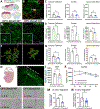BMAL1 loss in oligodendroglia contributes to abnormal myelination and sleep
- PMID: 37657440
- PMCID: PMC10873033
- DOI: 10.1016/j.neuron.2023.08.002
BMAL1 loss in oligodendroglia contributes to abnormal myelination and sleep
Abstract
Myelination depends on the maintenance of oligodendrocytes that arise from oligodendrocyte precursor cells (OPCs). We show that OPC-specific proliferation, morphology, and BMAL1 are time-of-day dependent. Knockout of Bmal1 in mouse OPCs during development disrupts the expression of genes associated with circadian rhythms, proliferation, density, morphology, and migration, leading to changes in OPC dynamics in a spatiotemporal manner. Furthermore, these deficits translate into thinner myelin, dysregulated cognitive and motor functions, and sleep fragmentation. OPC-specific Bmal1 loss in adulthood does not alter OPC density at baseline but impairs the remyelination of a demyelinated lesion driven by changes in OPC morphology and migration. Lastly, we show that sleep fragmentation is associated with increased prevalence of the demyelinating disorder multiple sclerosis (MS), suggesting a link between MS and sleep that requires further investigation. These findings have broad mechanistic and therapeutic implications for brain disorders that include both myelin and sleep phenotypes.
Keywords: BMAL1; OPC; circadian; demyelination; multiple sclerosis; myelin; oligodendrocyte; sleep.
Copyright © 2023 Elsevier Inc. All rights reserved.
Conflict of interest statement
Declaration of interests The authors declare no competing interests.
Figures






References
Publication types
MeSH terms
Substances
Grants and funding
LinkOut - more resources
Full Text Sources
Medical
Molecular Biology Databases

